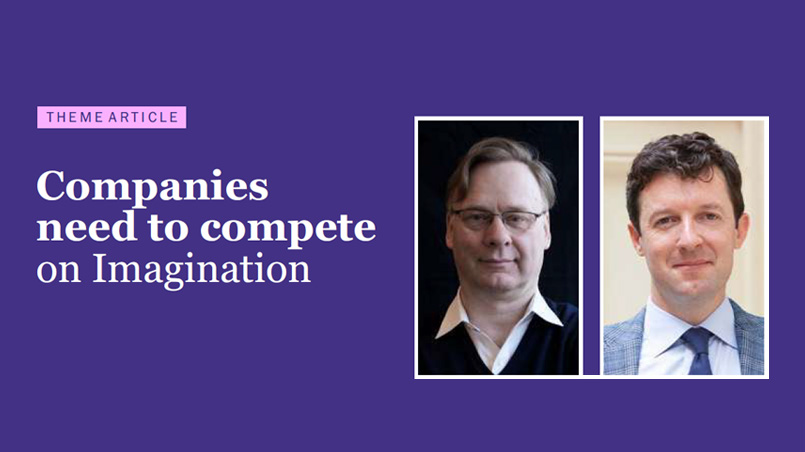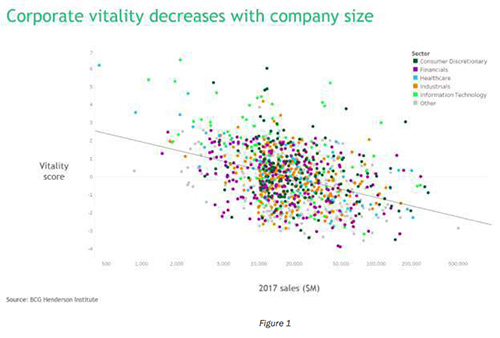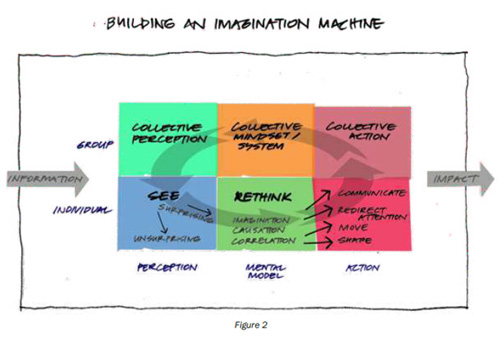 Connect with us
Connect with us

 Oct 06, 2022
Oct 06, 2022
As business environments become more changeable and long term growth rates decline, companies increasingly need to innovate. We know the powerful effects of innovation, but what is upstream of innovation? How can we understand and shape the murky mental territory that leads to good ideas: the realm of imagination? Big businesses often struggle to make use of imagination. They may try to make it a predictable process, and end up with routinization and incrementalism. Or they may treat it like a magical power, celebrated in tales of great innovators, in the hope that good ideas will appear as needed. As companies grow, it becomes harder to be imaginative. Larger companies tend to focus on exploiting what they know and what originally gave them scale. Corporate vitality potential for future growth decreases with size (Figure 1) (as seen in BCG Henderson Institute's analysis - 'The Global Landscape of Corporate Vitality'.)

The role of directors needs to expand – beyond classical fiduciary responsibility, towards ensuring constant renewal of the business through reimagination.
Companies must increasingly compete on imagination, but we don't have a clear idea of how imagination works or how to systematically improve it. How could we cultivate imaginative capacity, rather than leaving it to chance, intuition, or mechanistic processes?
What imagination is
To see what imagination is, we can compare humans to other animals: for example, a goldfish lives in the realm of 'what is', working with just what is in front of it, without any standpoint to reflect on its situation. (Suddendorf, T, and Dong, A, On the Evolution of Imagination and Design, The Oxford Handbook of the Development of Imagination, 2013) If a goldfish had imagination, it could picture a different situation, like being in a larger tank. Holding this mental image in mind, it could look at its current tank, and reflect that not everything is inevitable.
Imagination is the ability to think counterfactually. Rather than living in the realm of 'what is', imagination gives us the ability to explore the realm of 'what is not, but could be', to enable us to conceive and create new things and to shape what is.
How imagination works
Let's look at how imagination works, starting at the level of an individual – where imagination is part of a process involving perception, thinking, and taking action.
See: Our brains use sensory input to create a mental model, (Friston et al, (2006) 'A free energy principle for the brain', Journal of Physiology) which is sustained by assumptions: our brain models the desk in front of us, even though we are not staring at it all the time. As we perceive our environments, we may encounter surprises – observations that bring new information to the model, causing us to update our assumptions.
Rethink: Let's suppose you receive a surprising piece of information: you reach for your wallet but it is not in your pocket. At the most basic level, your brain will assess historical patterns – e.g., weighing the probabilities that the wallet has been stolen or left in a taxi. However, human brains can also work at a higher level, enabling you to ask: 'What if my wallet was stolen?' And you can paint a mental picture of what things would be like if that were the case. The ability to create this counterfactual sketch is your imaginative capacity. (Judea Pearl (2018), The Book of Why) It can be leveraged to imagine ways to help you keep track of your wallet in future or even dream up new services, like a 'find my iPhone' tool – but for everything in your life.
Act: Imagination is not a purely mental activity. Our thinking leads to action and what we learn from acting further shapes our imagination. This action might comprise communication, redirecting attention to new objects or signals, moving in the world to change our perspective, or shaping some aspect of the world – like conducting an experiment or creating a prototype.
For example, early last century, Charles Merrill revolutionized banking. (Gavetti, G and Menon, A., (2016) Evolution Cum Agency: Toward a Model of Strategic Foresight. Strategy Science 1(3):207-233). His vision began with idea that the methods of retailing could be brought to banks inspired by his previous work in the supermarket business. (Charles Merrill and the Democratization of Stock Ownership from Forbes Greatest Business Stories of All Time by Daniel Gross, found on https://www.stephenhicks.org/) This prompted him to ask 'what if' questions: what if a bank could offer a range of transparently priced products? What if these could be accessible to middle class Americans? And he also acted: he did customer research (redirecting attention, gaining new perspectives) and tested out his developing ideas, which fed back into his mental model for the bank of the future. His business model was an extraordinary success for Merrill, Lynch & Co., and marked a dividing line between two eras of Wall Street. (Sobel R (2000), Dangerous Dreamers: The Financial Innovators from Charles Merrill to Michael Milken)

The social dimension
Imaginative achievements are not just produced by one person. One's own imagination works in conjunction with the perceptions, imagination, and actions of others, to create the possibility of collective innovation. The individual act of imagining (lower part of figure) is part of a cycle that can span a whole organization or business ecosystem (upper part of figure, Figure 2).
When individuals communicate, this enables amplification, evolution, and collective action on ideas. Over time, collective action shapes a set of habits, roles, and expectations, the collective mindset, which can become a self sustaining system. These habits and expectations shape what ideas are shared and promoted in the group: collective perception. We experience this as knowing what to avoid and what would 'go down well' in certain meetings, and as a group will to adopt shared ideas. To close the loop, this group influence partly shapes how individuals see the world: what they notice and find surprising and inspiring – the triggers for individual imagination.
To return to the Charles Merrill example, his imaginative ideas were developed in communication with others, particularly researcher Ted Braun, and led to collective actions: research, and efforts to engage and change the ideas of an often recalcitrant company. (Gavetti, G and Menon, A., (2016) Evolution Cum Agency: Toward a Model of Strategic Foresight. Strategy Science 1(3):207-233) The imaginative process extended beyond the individual, as Merrill worked to make his and Braun's vision come alive in the minds and habits of investors, employees and early adopting customers.
What stops big companies from being imaginative
To turn a company or business ecosystem into an 'imagination machine', therefore, we need to not only focus on individuals, but the collective imagination cycle in which they are embedded. Looking at the steps in the diagram above, we can identify the points at which collective imagination can fail in big companies.
1. Size leading to less exposure to the outside.
Larger companies become miniature societies, with more people tied up within the society and fewer connecting with the outside world. When there is less exposure to what is surprising and unpredictable, there is less to feed the imagination.
2. A focus on averages rather than exceptions.
Another bottleneck in perception is the tendency to not pay much attention to outliers and anomalies. This is partly due to reporting being focused on averages (e.g., average sales volumes) – so that people higher up can get the overall picture rather than anomalies (e.g., individual successful or failed sales) -which may be change signals or sources of inspiration.
3. Mental models become stuck.
The mental models of a successful organization tend to become uniform and entrenched. This problem is compounded by a lack of self awareness of mental models, which are often implicit and treated as common sense or even as immutable facts.
4. The tyranny of metrics. Companies often focus on efficiently executing one business model, and the associated targets and metrics become the main ways of judging success. This can come at the expense of seeing possibilities and dabbling with new models for which there is no clear way to measure and reward success.
5. Roles become highly specified.
In large companies it can make little sense to act outside what you are expected to accomplish. Thus, there is limited incentive or autonomy for exploration. But imagination often works by following up serendipitous moments, which lead you far from what you expected to be doing.
6. Lack of social transmission.
Even if individuals are imaginative, there might be barriers to the transmission of ideas across a group, due to a lack of collaboration opportunities, a high bar for proposing new ideas and a fear of failure, or restrictive communication protocols.
7. Imagination is seen as only mental.
A key part of the imaginative process is action - beyond just communication: doing research or testing early stage efforts. Without these efforts to shape or 'prod' the world, there is no feedback and no surprising data to trigger further elaboration. Building an imagination machine How could we build an 'imagination machine', that is, a business where the imaginations of individuals working together are fully supported by design? Below are some key measures to take which we elaborate more deeply in our book 'The Imagination Machine' (HBR Press, June 2021). (QR Code for this book has been given at the end of this article.)
Contact with the unknown: Ensure that employees and managers are regularly exposed to the unfamiliar and unknown, e.g., by sending staff on secondments to different work environments. Directors, particularly independent ones, play an important role in this: with their large networks and breadth of experience, they act like antennae for the organization, receiving and interpreting signals from different firms and industries.
Focus on anomalies: Ensure that interesting anomalies are reported alongside averages and expected results. For example, each executive could be required to present an intriguing or thought provoking thing they encountered in their division once per week. Directors, given their strategic focus and outside in perspective, can also provide value by highlighting anomalies they observe e.g., when contrasting the company with other businesses they have insight into.
Explicit mental models: Be aware that mental models are not inevitabilities. To anchor this, explicitly articulate the core elements of the collective mental model on which the business model rests. Such self awareness of assumptions and mental models will facilitate the navigation and choice of alternative ones.
Counterfactual as well as factual skills: Focus on cultivating the mental skills underpinning imaginative thinking. This does not mean simply hiring people who worked in creative industries, but testing for the core skills of imagination in hiring and for promotion decisions: e.g., candidates could be tested on contingent thinking (What are five 'what if' questions you would ask in this or that business situation?). (On managing talent for a different but related set of mental skills- BCG's article - 'Strategy, Games, and the Mind', March 2018)
Playfulness: Play involves testing out things that one can do easily but might not have thought to try yet, without much premeditation - it is a form of accelerated, de-risked learning. (BCG's article - 'The Playful Corporation', April 2018) Companies should foster playfulness, allowing people to, e.g., suggest idiosyncratic ideas in meetings or trying out new ideas. Allowing low cost action and feedback is key to support the cycle of imagination. Contrary to the staid common image of boards, they too can leverage play to stretch their thinking e.g., by engaging one of the imagination games we describe in 'The Imagination Machine'.
Open competition of ideas: Foster the expression and competition ideas, either in informal ways with the CEO regularly soliciting ideas from her team or more formally in firm wide competitions. To encourage interesting, but unusual and untested ideas, leaders could also share historical examples reminding people just how weird things that now seem unexceptional seemed when they were completely new (e.g., fridges, staplers, printed books, cars).
Cognitive diversity: Whether imagination works well is tied to how uniform and rigid our collective world view is. Diversity is not limited to deploying people with different backgrounds, races and genders - it can also be achieved through individuals with different thinking patterns, those who are able to change vantage points, or who have absorbed multiple different worldviews and perspectives across their life. (BCG's article - 'How Diverse Leadership Teams Boost Innovation', January 2018)
Evolving routines and models: Over time, the patterns of collective action in a company shape the dominant set of mental habits, roles, and expectations, which can become a self sustaining system. Companies need to avoid such entrenchment by allowing routines and models to evolve. (BCG's article- 'The Self Tuning Enterprise', September 2015) Independent Directors have a particularly crucial role to play in challenging the status quo based on their external perspective.
Conclusion
The idea that only entrepreneurs imagine new businesses, while big companies focus on managing established ones at scale, is falling apart. All companies face increasingly unpredictable environments and the prospect of stagnation or disruption if they do not continuously innovate. Fortunately, business environments are increasingly malleable, and offer many new opportunities to create and capture value, if we can first imagine them.
As well as competing on efficiency, we must therefore increasingly compete on imagination. Accordingly, the role of directors needs to expand - beyond classical fiduciary responsibility, towards ensuring constant renewal of the business through reimagination. Independent Directors are particularly important in this context due to their outside-in perspective, broad networks, and diverse experience, enabling them to suggest surprising ideas, question the status quo, and ensure that mental models keep evolving.
Additional Reading:
(1.) The Imagination Machine' (HBR press, June 2021) is available at https://www.amazon.in/Imagination-Machine- Create-Companys-Future/dp/1647820863; for more info, visit https://theimaginationmachine.org/
(2.) HBR article by Martin Reeves and Jack Fuller: We Need Imagination Now More Than Ever https://hbr.org/2020/04/we-need-imagination-now-morethan-ever
(3.) TED Talk by Martin Reeves: Why play is essential for business https://www.ted.com/talks/martin_reeves_why_play_is_e

He is the Founder of Archive Health, a company reimagining mental and physical health care. He holds a doctorate in theology from the University of Oxford, UK.

He is Managing Director and Senior Partner in the Boston Consulting Group's (BCG) office in San Francisco, USA. He is also Chairman of the 'BCG Henderson Institute', BCG's vehicle for exploring ideas from beyond the world of business, which have implications for business strategy management. He is the co-author of The Imagination Machine (HBR Press, 2021), Your Strategy Needs a Strategy (HBR Press, 2015), and the Inspiring the Next Game series (DeGruyter, 2021). Having joined BCG in 1989, his consulting career has focused on strategy – with equal emphasis on idea origination and development, and application by consulting with clients on their strategy challenges.
Owned by: Institute of Directors, India
Disclaimer: The opinions expressed in the articles/ stories are the personal opinions of the author. IOD/ Editor is not responsible for the accuracy, completeness, suitability, or validity of any information in those articles. The information, facts or opinions expressed in the articles/ speeches do not reflect the views of IOD/ Editor and IOD/ Editor does not assume any responsibility or liability for the same.
About Publisher

Bringing a Silent Revolution through the Boardroom
Institute of Directors (IOD) is an apex national association of Corporate Directors under the India's 'Societies Registration Act XXI of 1860'. Currently it is associated with over 30,000 senior executives from Govt, PSU and Private organizations of India and abroad.
View All BlogsMasterclass for Directors
Categories